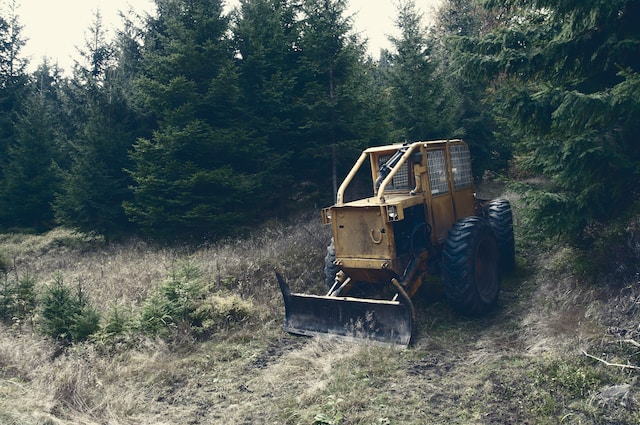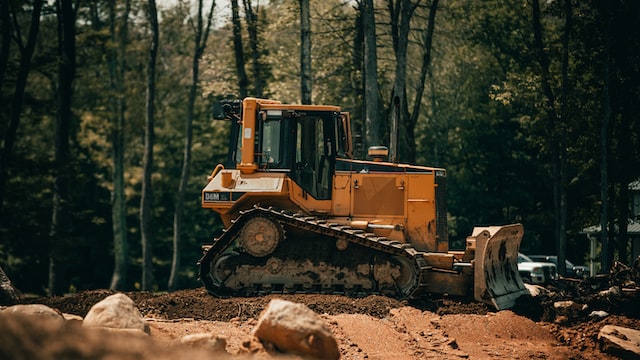Bulldozers are used for construction while excavators are mostly used in mining. Although both machines have a lot of power, they use it differently. Bulldozers push dirt and debris while excavators dig holes and trenches.
What is a bulldozer?
(Photo by Marek Novotný on Unsplash )

A bulldozer is a powerful construction machine that is primarily used for pushing and moving large quantities of earth, rocks, debris, or other materials during various types of construction and earthmoving projects. It is a heavy-duty vehicle equipped with a large metal plate called a blade that is mounted on the front of the machine. The blade is capable of pushing, lifting, and moving materials across the ground.
Bulldozers are designed to operate in rugged terrains and are known for their exceptional strength and durability. They are commonly used in a wide range of industries, including construction, mining, forestry, agriculture, and land clearing. These versatile machines play a crucial role in various tasks such as excavation, leveling, grading, pushing, and demolishing.
The main components of a bulldozer include the engine, transmission, undercarriage, tracks, and the blade. The engine provides the power necessary to move the machine and operate the various hydraulic systems. The transmission system allows for different speed ranges and directional control. The undercarriage consists of tracks, which provide stability and traction on uneven surfaces, and the track frames that support the weight of the machine.
The blade is the most notable feature of a bulldozer. It is attached to the front of the machine and can be raised, lowered, tilted, and angled to perform different functions. The blade can be straight or U-shaped, with the latter being more common. Straight blades are better suited for tasks like grading and pushing, while U-shaped blades are efficient for tasks that require the collection and transport of materials.
Bulldozers are typically operated by skilled operators who use control levers and pedals to maneuver the machine. The controls allow the operator to control the speed, direction, and movement of the bulldozer. Modern bulldozers often feature advanced technology, including hydraulic systems, GPS guidance, and automated controls, which enhance their efficiency and precision.
In addition to the blade, bulldozers can also be equipped with other attachments to perform specific tasks. For example, rippers can be attached at the rear of the machine to break up hard materials like rocks and compacted soil. Winches and winch blades can be added to assist in pulling or dragging heavy objects or to perform tasks in areas with limited access.
Safety is paramount when operating a bulldozer. Operators must undergo proper training and certification to ensure they have the necessary skills and knowledge to operate the machine safely. They must also follow strict safety protocols and wear personal protective equipment to minimize the risk of accidents or injuries.
Overall, bulldozers are essential machines in the construction and earthmoving industries. Their robustness, versatility, and power make them indispensable for various projects that require the movement and manipulation of large quantities of materials. By efficiently moving earth and debris, bulldozers contribute to the development and progress of infrastructure projects, land clearing operations, and many other construction activities.
What is an excavator?
(Photo by Gerold Hinzen on Unsplash )

An excavator is a heavy construction machine that is primarily used for digging and excavation tasks. It is a versatile piece of equipment that consists of a boom, a dipper or stick, and a bucket, all mounted on a rotating platform called the house. The house is positioned on top of an undercarriage with tracks, which allows the excavator to move and operate in various terrains.
The boom is a long arm that extends from the house and provides reach and height for digging operations. It is connected to the dipper or stick, which is a smaller arm that can be extended or retracted to adjust the depth of the excavation. At the end of the dipper is the bucket, which is a large container with teeth or cutting edges that can scoop up and carry materials such as soil, rocks, or debris.
Excavators are powered by engines and hydraulic systems that provide the necessary force and control for the machine’s operation. The engine generates power, while the hydraulic system enables the movement of the boom, dipper, and bucket, as well as other attachments that may be used with the excavator.
The operator of an excavator uses controls in the cab to maneuver the machine. These controls allow for precise movements of the boom, dipper, and bucket, as well as the rotation of the house. The operator can dig, scoop, lift, and swing the excavator to perform a wide range of tasks, including excavation, trenching, grading, material handling, demolition, and more.
Excavators come in various sizes, from compact mini excavators that are suitable for small-scale projects or working in tight spaces, to large hydraulic excavators used in major construction sites or mining operations. The size of the excavator depends on the specific requirements of the project and the type of materials being handled.
Attachments can be added to the excavator to enhance its versatility and enable it to perform specialized tasks. Some common attachments include hydraulic breakers for demolishing concrete structures, grapples for handling logs or rocks, augers for drilling holes, and thumbs for gripping objects. The ability to interchange attachments makes excavators adaptable to different job requirements.
Excavators are widely used in the construction industry, as well as in road building, landscaping, mining, and utility projects. They play a crucial role in tasks such as digging foundations, trenches, and ditches; loading trucks with materials; clearing land; and demolishing structures. Their efficiency, power, and ability to work in various terrains make them indispensable machines for many types of projects.
Safety is of utmost importance when operating an excavator. Operators must be properly trained and certified to handle the machine safely. They must also follow safety protocols, wear appropriate personal protective equipment, and be aware of potential hazards in the work area.
In conclusion, excavators are heavy construction machines designed for digging and excavation tasks. With their powerful digging capabilities and versatility, they are essential equipment for a wide range of construction and earthmoving projects. Excavators contribute to the efficient and precise execution of tasks, saving time and labor while enhancing the productivity and progress of various industries.
Bulldozers Vs Excavators – Key differences
Bulldozers and excavators are both heavy construction machines commonly used in the construction and earthmoving industries. While they may share some similarities, there are key differences between the two:
Function: Bulldozers are primarily designed for pushing and moving large quantities of earth, rocks, and debris. They excel in tasks such as grading, leveling, and pushing materials across the ground. On the other hand, excavators are primarily used for digging and excavation tasks. They are highly versatile machines capable of digging trenches, excavating foundations, and handling various materials.
Design and Attachments: Bulldozers feature a large metal blade mounted on the front of the machine. The blade can be straight or U-shaped and is used for pushing and moving materials. Excavators, on the other hand, consist of a boom, dipper (stick), and bucket. The bucket is used for digging and scooping materials. Excavators can also be equipped with various attachments such as hydraulic breakers, grapples, augers, and thumbs, which enhance their versatility and enable them to perform specialized tasks.
Movement: Bulldozers primarily move on tracks, which provide stability and traction on uneven surfaces. They are designed for traversing rough terrains. Excavators also have tracks for movement, but some models may have wheels. The tracks on excavators allow for stability and maneuverability in different types of terrain.
Operator Position: In a bulldozer, the operator sits in a cab located at the rear of the machine, providing a clear view of the work area. This positioning allows the operator to have a direct line of sight to the blade and the surroundings. In contrast, the operator of an excavator sits in a cab that is mounted on a rotating platform, providing a 360-degree view of the work area. The rotation capability allows for greater flexibility in positioning the excavator for efficient digging and loading.
Applications: Bulldozers are commonly used for tasks such as land clearing, site preparation, road construction, and pushing large volumes of material. They are particularly effective in operations where earthmoving is the primary focus. Excavators, on the other hand, are used for a wide range of tasks including digging trenches, excavating foundations, lifting and placing heavy objects, demolition, and material handling. Their versatility makes them suitable for various construction projects.
Size: Bulldozers and excavators come in a range of sizes to suit different project requirements. However, excavators are generally available in a wider range of sizes, from compact mini excavators to large hydraulic excavators used in major construction projects and mining operations. Bulldozers are typically larger and more powerful machines compared to mini excavators but may be smaller in size when compared to large excavators.
Both bulldozers and excavators are essential machines in the construction industry, and their selection depends on the specific requirements of the project. While bulldozers excel in pushing and moving materials, excavators are versatile machines designed for digging and excavation tasks, with the ability to handle various attachments for added functionality.
Featured Image By – Billy Freeman on Unsplash









